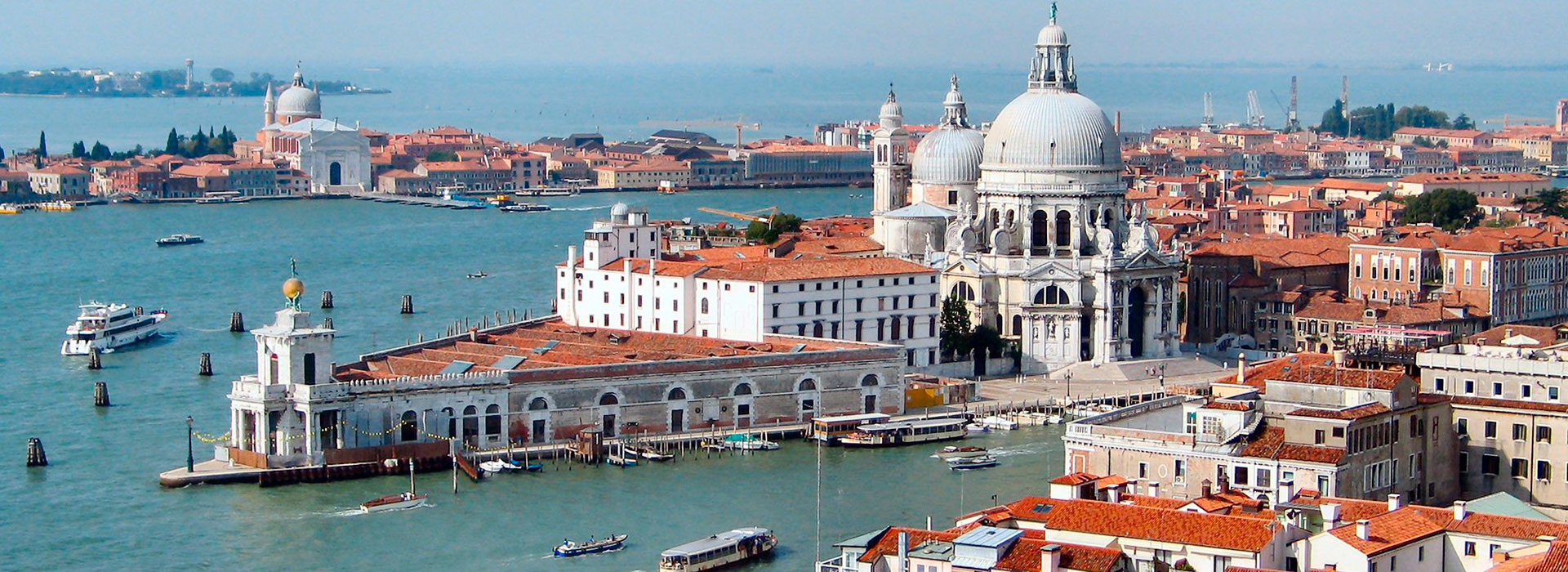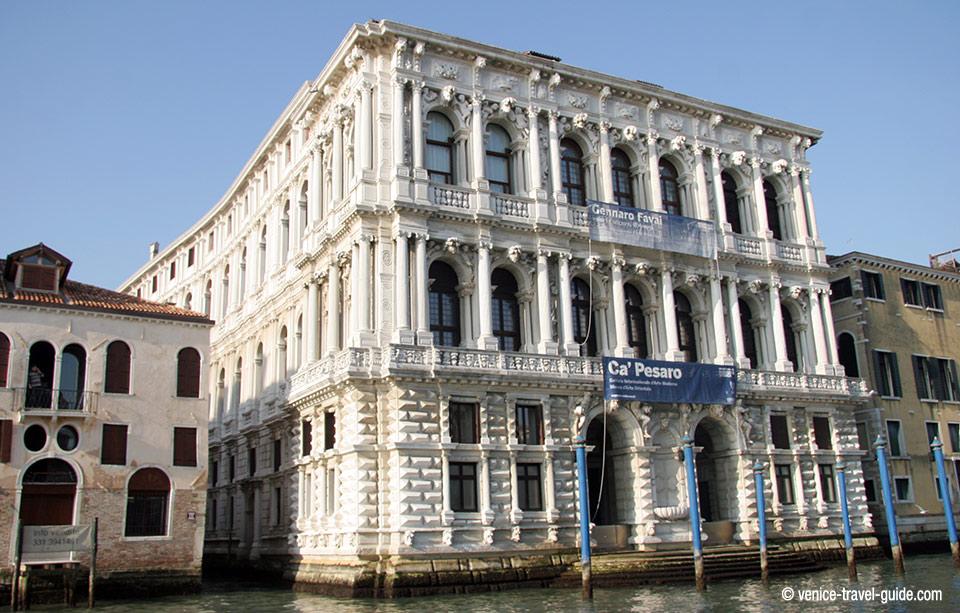Ca' Pesaro is a International Gallery of Modern Art. The museum contains important nineteenth- and twentieth-century collections of paintings and sculptures, including masterpieces by Klimt, Chagall, Kandinsky, Klee, Matisse and Moore.
Ca’ Pesaro (The Palazzo)
The grandiose palazzo, now the seat of the Galleria Nazionale d’Arte Moderna, was built in the second half of the seventeenth century for the noble and wealthy Pesaro family, to a project by the greatest Venetian baroque architect, Baldassare Longhena, who also designed the church of the Salute and Ca' Rezzonico.
Work began in 1659 starting from the land-side; the courtyard, with its striking loggias, was completed by 1676; the splendid facade on the Grand Canal had already reached the second floor by 1679, but, on Longhena’s death in 1682, the palazzo was still unfinished. The Pesaro family entrusted its completion to Gian Antonio Gaspari who concluded it in 1710, basically respecting the original project.
In creating Ca’ Pesaro, a masterpiece of Venetian baroque civic architecture, Longhena was inspired by Sansovinian classicism, elaborating solutions and idioms capable of expressing a new and sumptuous harmony. This is exemplified in the Grand Canal façade, with its complex composition, powerful but well-balanced: above a plinth decorated with lion-faces and monstrous headsrises a severe diamond-pointed, rusticated facade with two rows of windows, opened in the middle by twin doorways surmounted by mascarons and statues. The Sansovinian motif is more explicit on the first floor, with the insistent chiaroscuro rhythm of the deep-set arches and protruding columns. On the second-floor, designed by Antonio Gaspari, the facade is enriched by ornamentation in the pendentives and the entablatures.
No less regal is the vast entrance-hall, finely laid out along the axis of the entire building, spacious and well-defined, its half-light contrasting with the luminous clarity of the courtyard, articulated around the monumental well-head, and enclosed by a terrace and an ashlar-arcade, marked out by doric pilaster-strips, and overlooked by the upper storeys with their architrave-windows.
Sumptuous and imposing, but harmonious and organic in its structure, the palazzo was constantly enriched, during the long years of its construction, by an equally important process of interior decoration. The palazzo still conserves some of the fresco and oil decorations of the ceilings, the work of such artists as Bambini, Pittoni, Crosato, Trevisani and Brusaferro; there was also a ceiling by G.B. Tiepolo, with Zephyrus and Flora, which was transferred to the Museum of Ca’ Rezzonico in 1935.
But the collections of the Pesaro family, as documented in the archives, must have been even more remarkable, including such artists as Vivarini, Carpaccio, Bellini, Giorgione, Titian, Tintoretto, as well as the most famous Venetian artists of the seventeenth and eighteenth centuries. This great heritage had been completely dispersed by 1830, the year of the death of the last Pesaro, who had auctioned off most of the collection in London.
The palazzo passed first to the Gradenigo family and then to the Armenian Mechitarist Fathers, who used it as a college. It was finally bought by the Bevilacqua family, and became the property of Duchess Felicita Bevilacqua La Masa.
It was she who decreed the present usage of the building, bequeathing it to the city in 1898, as a museum of modern art.
Ca’ Pesaro Modern Art Gallery
The collection was enriched over the years by further acquisitions and donations. The former mainly consisted of works bought by the Town Council at the Venice Biennale: up unto the 1950s European art was favoured, in agreement with the Galleria Nazionale d’Arte Moderna of Rome, which generally acquired Italian works at the Biennale.
From the 1960s onwards a new policy was adopted, privileging Italian art. As a result there was a noticeable increase in the number of works by those artists already mentioned, who, thanks to the Bevilacqua La Masa Exhibitions and the polemics that surrounded them, had made Ca’ Pesaro famous as a driving force for innovation in Italian art. The collection of works from nineteenth-century Venice is also remarkable. As for the donations, they started with the founding donation by Prince Alberto Giovanelli, followed by Baron Edoardo Franchetti, Baron Ernst Seeger, Filippo Grimani, but above all by Associazione Industriali e Commercianti Veneziani.
In 1914 a number of notable works in wax by Medardo Rosso were acquired, and in the sixties the De Lisi bequest enriched the gallery with works by Morandi, De Chirico, Carrà, Kandinsky, Mirò and Matta, thus filling certain gaps left by the municipal policy of acquisition; finally, in 1990 the gallery received the valuable Wildt donation.
The lay-out has been completely redesigned, along with the information-apparatus, and it provides an illuminating introduction to a crucial period in art-history.
Layout and Collections
- Nineteenth-Century Venetian Art. The tour starts with this room devoted to Venetian painting of the second half of the nineteenth century. Painters such as Ippolito Caffi, Guglielmo Ciardi, Giacomo Favretto, Pietro Fragiacomo, Mario De Maria, Luigi Nono and Lino Selvatico testify to the variety of art in the city between the nineteenth and the early twentieth century.
- Nineteenth-Century Italian Art and Medardo Rosso. This room brings together nineteenth-century Italian works: there are paintings by Signorini (The Room of the Disturbed, 1865, and November, 1870), Fattori (The Explosion of the Caisson, 1878/80), De Nittis, Pellizza, Previati, Morbelli, flanked by an important but little-known work by Balla (Letizia Pesaro Maurogonato), in his pre-Futurist season. These are all significant works, essential for an understanding of the artists’ development. The Municipality of Venice was stirred by the presence of these artists at the Biennale to acquire their works, which testify to the vitality of Italian painting at the turn of the century.
Central Hall. Works from the First Biennali up to the 1930s. - Adolfo Wildt. This room on the Canal Grande is devoted to the valuable donation of the sculptures of Adolfo Wildt, offered in 1990 by the Wildt-Scheiwiller heirs. The great Milanese artist was a protagonist of the Symbolist season but also of a period of experimentalism and innovation that influenced later generations.
- The De Lisi Bequest: from Morandi to Kandinsky, from Casorati to Mirò, from De Chirico to Matta.
- The Ca’ Pesaro Movement. The first season of the Bevilacqua La Masa exhibitions organised by Nino Barbantini: from 1908 to 1924 the small rooms on the piano ammezzato of this palazzo were used to host lively exhibitions of new talents, bringing some of the most important Italian artists to public notice.
- Between the 40s and 50s: World Art. This room opens a small window onto the international art scene of the 1940s and ’50s; it is a heterogeneous but stimulating collection of works by artists who all helped to shape the history of twentieth-century art. The brief tour starts with a mature work by Jean Arp, Alou with Talons (1942), followed by Studio with Fruit-Bowl by Raoul Dufy from the same year, drawings by Henri Matisse from roughly the same period, The Opaline Vase and Fern, Fruit and Female Figure, and Tiberiade by Georges Rouault, a painting that belongs to a cycle on Gospel themes dating from the end of the forties.
- 1950s Italian Art. This room offers an overview of some tendencies of Italian art in the period after the Second World War. Figurative art, although under pressure from abstract tendencies and from “informalism”, is well represented by works by De Pisis, Pirandello, Cassinari and Fazzini. By contrast, the “informal” experiences of Birolli, Morlotti, Music, Afro and Perilli are flanked by the more rigorously abstract works of Bice Lazzari.
- Venice between New Front and Spatialism.
Library of the Galleria Internazionale d’Arte Moderna
The museum has an important specialised library. The Library of Ca’ Pesaro is open to the public from Monday to Friday, 9am to 1pm, and until 4pm on Tuesday and on Thursday. Closed Saturday, Sunday and public holidays
Ca' Pesaro opening times
- From April 1st to October 31st: Open 10:00 - 18:00. Last admission 17:00.
- From November 1st to March 31st: Open 10:00 - 17:00. Last admission 16:00.
- Closed on Monday, December 25th, January 1st and May 1st.
Map of Ca' Pesaro
AddressSanta Croce, 2076
30135 Venezia, Italia




